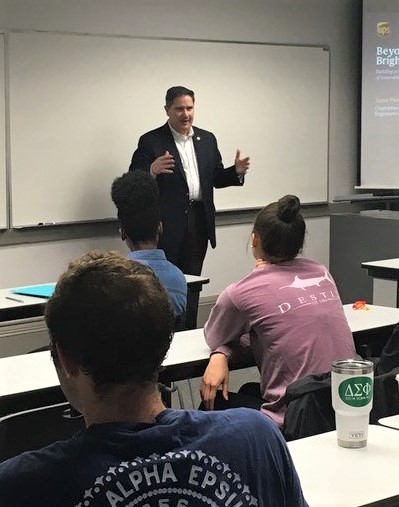What better way to learn about real-world business operations than from Atlanta’s own UPS?

Earlier this month, Juan Perez and Jim Winestock of UPS presented to Dr. Lynn Guhde‘s 400-level Operations Management class.
Perez currently serves as Chief Information and Engineering Officer and is a member of the UPS Management Committee. Winestock, an Oglethorpe alumnus and current Oglethorpe trustee, served 40 years with UPS, retiring as Senior Vice President of all U.S. Operations and a member of the 12-person UPS Management Committee.
UPS, a Fortune 50 Company ranked #44, employs 450,000 worldwide. With 100,000 vehicles and 500 aircraft (the world’s ninth largest airline), UPS delivers 19,000,000 packages every day, a number that rises to 30,000,000 during the holiday season.
In the class, Winestock outlined the daily production cycle and underscored the intensity of execution critical to success in a world-wide, multi-platform daily program of pick-up, transportation and delivery. He traced the growth of the company from its beginnings as a messenger service through its role as a retail store delivery service and—during his tenure—from the first common carrier throughout the 48 continental United States, to its service today as the global leader in package delivery. He stressed the increasing role of technology as the enabling architecture for the company’s mission.[contextly_sidebar id=”DsEjPK81WMbs3Fg3UwN16gSxV01RZKeU”]
Perez, with responsibility for all technology throughout the corporation managed via a staff of 6000, then traced the significance of technology to UPS operations from the inception of the internet and its impact on forecasting to the current corporate initiatives in artificial intelligence, autonomous vehicles, robotics and virtual reality, a clear example of the company’s place in the “Fourth Industrial Revolution”.
As network planning—second only to the selection, training, and guidance of their people—is the central element of daily success, UPS takes an active role in development of applications for use in the field.

For example, ORION (On-road, Integrated, Optimization and Navigation System) was created to direct and control deliveries every day. Using DIAD (Delivery Information Acquisition Device), now in its 6th generation, drivers are directed by ORION’s blend of hyper-accurate map data, analytics tools, telemetrics, current traffic data, customer data and operations research algorithms that optimizes each route and provides updates as the traffic and pick-up situation changes.
Perez credited UPS’s dedication and discipline in its application of innovation as a key to the company’s continuing success.






